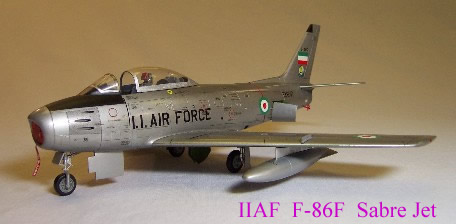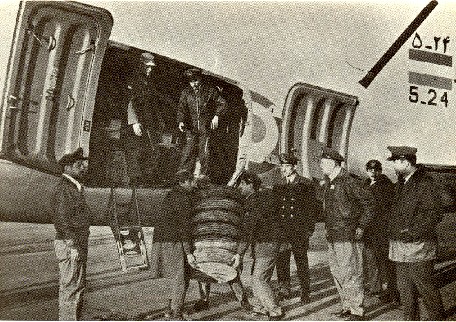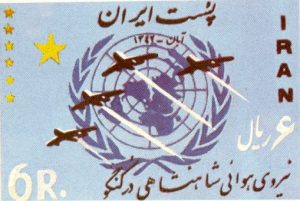North American F-86 F Sabre
« back to "Jet Fighters"
Shortly after the IIAF entered the “Jet age” by receiving T-33s and F-84s which opened the gates to a modern Air Force, the IIAF was getting ready for the more advanced F-86 fighter jets.
In 14April 1960 (24 Farvardin 1339) IIAF received it’s first squadron of F-86 F.
The pilots were chosen from veteran F-84 and the first squadron was formed in Mehrabad (1st. T.F.B.)which later expaned to Vahdati AFB .
The F-86 was involved in supporting the army in uprising of “Ghashghaees” in Shiraz.
Supporting the United Nation in Congo.
Served in “Golden Crown” for almost 10 years.
Creation and stablishment of our 1St. A.F.B. in Dezful ( Vahdati A.F.B.).
Replacing F-84s in Vahdati A.F.B. (Dezfull).
Training F-86 instructors for Pakistan Air Force which in return Pakistan agreed to train about 30 of our aviation cadets in Pakistan ( Hooshang Sedigh, Hooshang Vijheh, Mohammad Hadavand, Jahanvar Kamran, Daryoush Hamzavi,Shahram Roostami, Aboulfazl Hooshyar………. Were among these group).
The F-86 served the IIAF all the way till 1970 after the F-4 Phantoms came to service Almost all of our F-5, F-4 and
F-14 Instructors,Commanders and Base Commanders were veteran F-86 Pilots.
The F-86 truly deserves to be crowned as the best and most important fighters in IIAF.
Engine: One 2,681 kg (5,910 lb) General Electric J47-GE-27 turbojet engine.
Wing Span: 11.91 m (39 ft 1 in)
Length: 11.44 m (37 ft 7 in)
Height: 4.57 m (15 ft 0 in)
Weight: Gross 9,349 kg (20,610 lb)
Maximum Speed: 1,106 km/h (687 mph) at Sea Level
Range: 1,490 km (925 miles)
Accommodation: 1 Pilot
Armament: Six 0.5 in machine-guns in nose, two Sidewinder missiles, two 453kg (1,000 lb) bombs or eight 5 inch rockets under wings.
History:
First flight (XF-86) in 1 October 1947.
F-86 F “Sabre” Swept-wing version of the Naval FJ-1 Fury.
Over 10,000 of F-86 ( first swept wing jet fighter) were built in America, Australia, Canada, Italy and Japan.
They saw wide-spread service in the Korean war of 1950-1953 and many were still in service with air forces outside the USA in the 1970`s.
More than a dozen versions were built, for use as tactical and interceptor fighters, all-weather fighters and fighter bombers.
Congo Mission
In early December 1962 the Iranian Government received a request from the United Nations to provide some fighter aircraft for the UN forces (called ONUC) in the Congo, to replace Italian Air Force which had suffer a total loss in a peace keeping mission where renewed fighting between the UN and the break-away Katanga province had been going on.
The rebels had shot down the helicopter carrying Mr. Doug Hamershold, killing all passengers.
Belgians were supporting the rebels and the French had shot down the aircraft carrying Mosa Chombe (Rebels Leader). On 27 December after approval of H.I.M Mohammad Reza Shah Pahlavi, the mission was given to the Air Force Headquarter.
Gen. Khatami the commander of IIAF called Capt.Azarbarzin (Later Maj. General ),Capt. Seyed Javadi ( Later Maj. General, Died of brain tumor), Capt. Jahanbini (was Killed in a Crash ),Capt. Rabii (Later Lt. General and Commander of IIAF which was Killed by islamic regime in 1979 ) and Capt. Minusepehr ( Later Maj. General )and asked for volunteer, all 5 volunteered at the same time, so Maj. Seyed Javadi was “Elected” as “Mission Commander”.
Four Saber Jet( F-86-F) of Imperial Iranian Air Force from Vahdati Air Force Base with 9 pilots and 33 support personal participated in this mission ( From 16 Jan 1963 to 5 May 1963 = 26 Dey 1341 to 15 Ordibehesht 1342).
Maj. Amir Kamiabipour was given the task of “Planning”and in charge of the whole operation, which he did in the best possible manner. The success of this mission in whole is partly due to Maj. Kamiabipour efforts.
Capt. Mostafa Hadj Seyed Javadi was appointed as “Mission Commander” , known as 103rd Squadron.
The unit arrived at the Kamina airbase in Katanga on 19 January 1963.
The airbase was surrounded by rebels and the crew could not leave the base for over a month.
By this time there were two other UN fighter units at Kamina, the Swedish 22nd Squadron with 12 ship SAAB J29s and S29s, and the Philippine 9th Squadron with 6 ship Canadian built F-86Es. All three units were now formed into a UN Fighter Wing, with Swedish Colonel Sven Lampell as its first commander.
The IIAF crew were:
Maj. Amir Kamiabipour ” Mission Planner”
Capt. Mostafa Hadj Seyed Javadi “Mission Commander“.
1St.Lt. Iradj Mostafavi ( Later Brig. General )
1st. Lt Vahid Kimiagar ( Later Brig. General)
1st. Lt Mohsen Memarian ( Killed in Aircraft Crash)
1st. Lt Mohammad Alaghband ( Killed in Aircraft Crash)
1st. Lt Esmaeel Memari (Killed in Aircraft Crash)
1st. Lt Mohammad Abolmolouk ( Later Brig.General)
1st. Lt Mohammad Pezeshki ( Later Col.)
1st. Lt Nasser Zolali ( Later Brig.General, Died of Cancer )
1St.Lt. Ali Akbar Farywar (Later General) “commander of Support & Maintenance” and 33 maintenance and support crew. ( We would like to have the name of these crew )
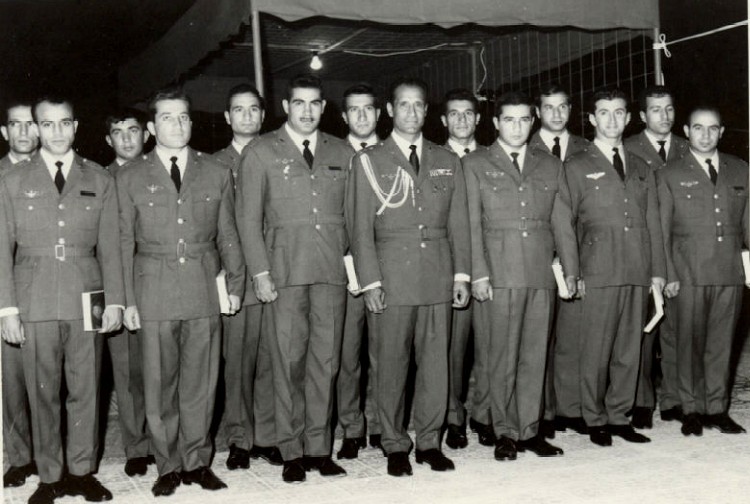
One C-47 “ Dakota” with 6 crew was assigned to support this mission.
The Aircraft commander was Capt. Hessam Mirtolooi ( Later general ).
The C-47 made 3 sorties from Tehran to Congo. C-47 had a hard time climbing over Kilimanjaro Heights.
The route of F-86 from Iran to Congo was Dezful –Tehran- Dhahran (Saudi Arabia)-Jadeh (Saudi Arabia) -Addis a baba ( Ethiopia)–Entebbe (Uganda)–Katanga( Congo). More than 6,300 Km. And over 10 Hours flight.
IIAF Aircraft were operational ready at all time and there was no accident only one incident during the operation which Lt. Alaghband’s aircraft was hit by bullet and was repaired and ready to fly in less than 24 hours.
The 4 ships F-86 of IIAF flew more sorties than Philippine and Sweden with total of 18 aircraft.
Iran was commended by united nation for their excellent performance.
After returning back to Iran Maj. Seyed Javadi, Major Rabii ( Base Operation Commander), Lt. Mostafavi and Capt. Farywar were decorated with medal for performance.
A special stamp was issued by Iranian Postal services 6 Month after the mission on United Nation Day.
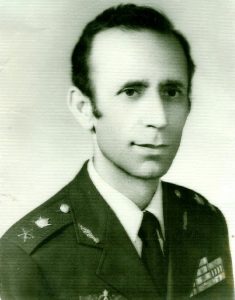
Thanks to: Mr. Leif Hellström for his cooperation on Congo Mission

